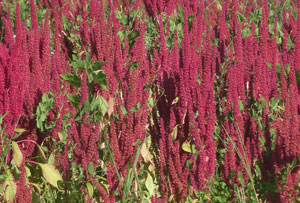
Alternative Crop Decision Tool:
Grain Amaranth

Alternative Crop Decision Tool:
Grain Amaranth
The questions below result in a composite score ranging from 0 to 100. A score of 0 indicates 'do not plant the crop', while a score of 100 would indicate 'there is absolutely no reason not to plant the crop'. There will be few instances of a score of 100. The icon(s) shown next to each question is meant to serve as a resource for producers relevant to each specified question shown. The questions below are intended to show red flag type concerns.
1. Do you have the ability/interest to clean (remove foreign material) and transport your crop a significant distance or are you willing to identity preserve store and ship your crop a significant distance if economically profitable?
Yes
No
No
2. Are the soils where you plan to plant amaranth poorly drained or prone to flooding?
Very poorly drained and prone to frequent flooding
Poorly drained and floods infrequently
Poorly drained
Soils drain well
Poorly drained and floods infrequently
Poorly drained
Soils drain well
3. Do you have the ability (and willingness) to implement a mechanical weed control system (e.g. cultivation or other means to decrease weed pressure). There are currently no registered herbicides for use with amaranth.
Yes, stale seedbeds, cultivation, and hand removal
Yes, cultivation
No
Yes, cultivation
No
4. With contract production of a small acreage crop, it is not unrealistic for payment to be several months after harvest. Is this cash flow scenario a significant concern for your operation?
No, I can cash flow a small acreage crop if the economic benefits justify
Yes, but a few months is anticipated in my planning
No, not receiving payment for several months could create cash flow issues for my operation
Yes, but a few months is anticipated in my planning
No, not receiving payment for several months could create cash flow issues for my operation
5. Do you actively scout your crops during key growth periods? Can you effectively manage your herbicide program to avoid residual (carry-over from prior crop) chemical issues with amaranth?
Yes
No
No
Your Results
X
